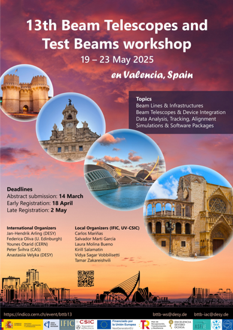Conveners
Lectures: I
- Jan-Hendrik Arling (Deutsches Elektronen-Synchrotron (DESY))
Lectures: II
- Tamar Zakareishvili (Univ. of Valencia and CSIC (ES))
Lectures: III
- Anastasiia Velyka (Deutsches Elektronen-Synchrotron (DE))
Lectures: IV
- Tamar Zakareishvili (Univ. of Valencia and CSIC (ES))
On March 22nd, 1985 the first beam was accelerated which marked the beginning of 40 years of highly reliable operations. Since then, it plays an important role in the particle physics landscape. While no experiment was performed at DESY II, it served as a pre-accelerator for the DORIS storage ring, the PETRA storage ring and thus the one-of-its kind proton-electron collider HERA.
While...
Track reconstruction is a key ingredient to extract the properties of the Devices Under Test.
The precision of the reconstructed tracks and their extrapolation to the Devices Under Test depends on the intrinsic resolution of the reference devices and how precise it is known their positioning and orientation in the system. A track based alignment can help to accurately determine the geometry...
In high energy physics experiments, hybrid pixel detectors are an integral part of the tracking systems closest to the interaction points, where their good spatial resolution and high radiation resilience allow for particle tracking by connection of “dots” registered in different layers of an onion-like detector. Another approach to particle detection and tracking relies on a complex analysis...
Nuclear medicine is a branch of medicine that uses radiation to diagnose and treat diseases, one of the most representative being cancer. Although scanners for medical imaging are used daily, there is still room for improvement in terms of energy, spatial and timing resolutions. At the same time, regarding cancer treatment, in the last years hadrontherapy is becoming a key technique in...
